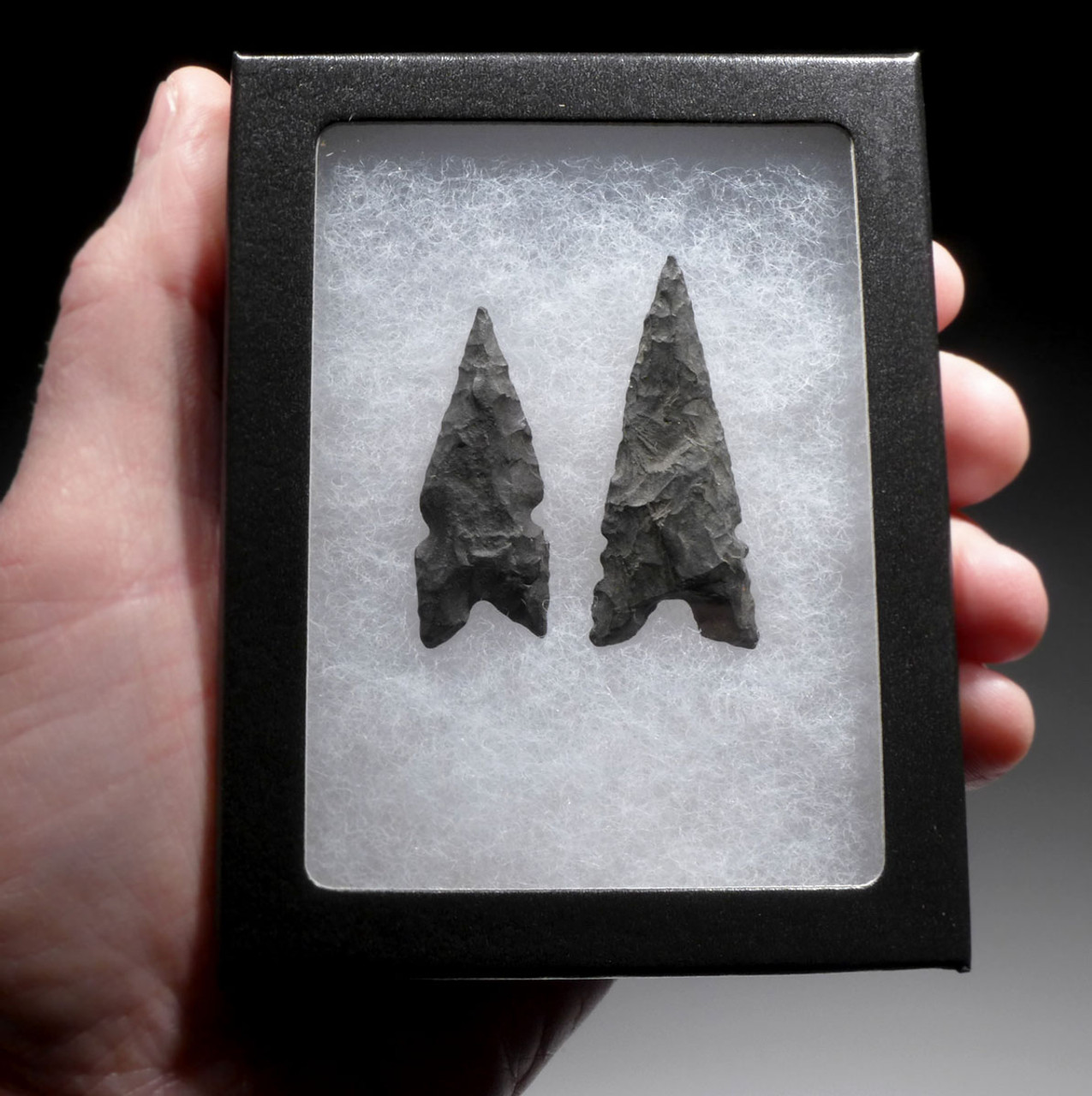Product Description
SEE MORE AFRICAN NEOLITHIC ARROWHEADS
This premium set includes two FINEST POSSIBLE GRADE indurated shale African Capsian Neolithic projectile point arrowheads tat were found on an exposed African Neolithic site in the Sahara Desert in Northwest Africa. Each was masterfully fashioned by African Neolithic humans (Homo sapiens sapiens) between 10,000 and 4,700 years ago. The projectile points in this set come from a small, select collection we have been holding onto for the duration of more than two decades. They are exceptional and complete, masterfully flaked. They display rare, delicate and unbroken features, as well as exceptional symmetry. Very seldom do arrowheads of this type, survive undamaged as these have.
Each of these specimens are top grade collector examples far exceeding the bucket-loads of common projectile points often found and offered for sale.
We have been obsessively collecting the finest African Neolithic Capsian arrowheads for 20 years and this specimen set comes from a small, select group we have been holding onto for the duration of more than two decades. We have been to the source in the Sahara and scoured literal buckets and barrels of tens of thousands of arrowheads each year, for many years. Over the past decades, we have also purchased large private collections in America and Europe. In all this time, we would set aside the RAREST OF THE RAREST arrowheads of this Neolithic culture, and it is now time for us to sell some from this private, ultra-rare stash. The collection is small and limited. Each piece represents the highest degree of workmanship that we have ever seen. The sites where arrowheads like this were once found, have been entirely picked clean for years. In over the last two decades, poor safety and security in the desert, as well as changing laws in North Africa, prevent any new collecting or discoveries to be made, making these artifacts increasingly desirable and valuable.
If you strive to build a super-select collection of only the finest, rare specimens rather than boxes and boxes of ordinary types that will never appreciate or impress, then this offering is for you!
HISTORY
In the final Pleistocene and early Holocene, the Sahara was believed to be a highly favorable environment for hunters, gatherers and pastoralists. Freshwater lakes existed between the dunes in what is now the Tenere region, Lake Chad was eight times its current size, the highlands supported Mediterranean forest trees, and a large fauna of animals flourished. The slow drying out process of the Sahara, began 7,000 years ago and ended 4500 years ago resulting in the barren conditions that exist to this day. As we progress from the time from the end of the Pleistocene to the end of the Paleolithic Period, we see man relying more on meat from raised animals as opposed to hunted animals.
It is likely that the presence of abundant small game and fish necessitated the manufacture of small flaked stone projectile points at a time when the Sahara was cooler and still teeming with life, thousands of years ago. It is also highly likely that these projectile points served as weapons against other humans.
From a slightly earlier time period, a late Pleistocene graveyard was discovered at Jebel Sahaba, north of Wadi Halfa in Sudanese Nubia. These burials date from approximately 18,000 to 13,000 years ago. Many people were buried there that had fallen victim to violent deaths having been killed by microlithic weapons and small arrowhead projectiles. One man had 110 projectile points associated with his skeleton which had entered his body as stone barbs and points of projectiles. Two of the projectiles were still embedded in his skull.
The earliest blade industry in North Africa is known as the IBERO-MAURUSIAN TRADITION. This tradition begins in the region around 25,000 years ago and is eventually superseded by another blade tradition called the CAPSIAN TRADITION. The Capsian industry runs simultaneously with the Ibero-Maurusian, beginning 11,000 years ago (9,000 years ago in the Northwest region). Most notable during the era of these two traditions is the proliferation of various blades and bladelets ushering in MICROLITHIC technology. Microliths are tiny flake blade tools and segments of blades that are used as they are or set in composite tools of wood or bone for use as barbs or to make saws.
The blades and projectile points of the CAPSIAN TRADITION represent some of the most delicately flaked and beautifully executed smaller stone tools of modern humans. By this time, the flaking methods utilize small punches for extreme control in the removal of material and shape of the blade being made. Some points were so perfectly executed that they were not used at all, but likely served as items of prestige by their owner and are sometimes found in association with burials.
 US DOLLAR
US DOLLAR
 EURO
EURO
 AUSTRALIAN DOLLAR
AUSTRALIAN DOLLAR
 CANADIAN DOLLAR
CANADIAN DOLLAR
 POUND STERLING
POUND STERLING












